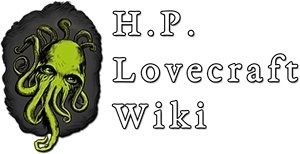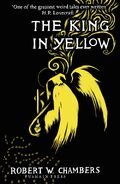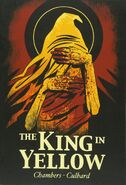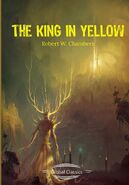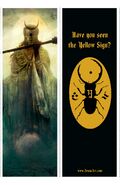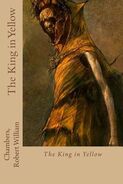No edit summary |
No edit summary |
||
| (5 intermediate revisions by 4 users not shown) | |||
| Line 1: | Line 1: | ||
| − | {{Inmythos}} |
||
| − | {{weirdtales}} |
||
{{infobox story |
{{infobox story |
||
| storyurl = https://en.wikisource.org/wiki/The_King_in_Yellow/full |
| storyurl = https://en.wikisource.org/wiki/The_King_in_Yellow/full |
||
| − | | author = Robert W. Chambers |
+ | | author = [[Robert W. Chambers]]|title = ''The King in Yellow'' |
| + | |publisher = F. Tennison Neely |
||
| ⚫ | ''' |
||
| + | |image = TheKinginYellow1.jpeg |
||
| + | |genre = * Short Fiction |
||
| + | * Horror |
||
| + | * Weird Fiction |
||
| + | |media_type = Print |
||
| + | }} |
||
| + | {{Weirdtales}} |
||
| ⚫ | '''The King in Yellow''' is a collection of short stories written by [[Robert W. Chambers]] and published in 1895. The stories could be categorized as early horror fiction or Victorian Gothic fiction, but the work also touches on mythology, fantasy, mystery, science fiction and romance. The first four stories in the collection involve a fictional two-act play of the same title: ''The King in Yellow'']]. |
||
==Stories== |
==Stories== |
||
The first four stories are loosely connected by three main devices: |
The first four stories are loosely connected by three main devices: |
||
| − | * A play in book form entitled The King in Yellow |
+ | * A play in book form entitled ''The King in Yellow.'' |
| − | * A mysterious and malevolent supernatural entity known as The King in Yellow |
+ | * A mysterious and malevolent supernatural entity known as [[The King in Yellow (entity)|The King in Yellow]]. |
| − | * An eerie symbol called [[ |
+ | * An eerie symbol called the [[Yellow Sign]]. |
| − | The color yellow signifies the decadent and aesthetic attitudes that were fashionable at the turn of the 19th century, typified by such publications as The Yellow Book, a literary journal associated with Oscar Wilde and Aubrey Beardsley. It has also been suggested that the color yellow represents quarantine — an allusion to decay, disease, and specifically mental illness. For instance, the famous short story |
+ | The color yellow signifies the decadent and aesthetic attitudes that were fashionable at the turn of the 19th century, typified by such publications as ''The Yellow Book'', a literary journal associated with Oscar Wilde and Aubrey Beardsley. It has also been suggested that the color yellow represents quarantine — an allusion to decay, disease, and specifically mental illness. For instance, the famous short story ''The Yellow Wallpaper'', involving a bedridden woman's descent into madness, was published shortly before Chambers' book. |
| − | These stories are macabre in tone, centering on characters that are often artists or decadents. The first story |
+ | These stories are macabre in tone, centering on characters that are often artists or decadents. The first story ''The Repairer of Reputations'', is set in an imagined future 1920s America, whose history, being at odds with the knowledge of the reader, adds to the effect of its unreliable narrator. The next three are set in Paris at the same time. |
The other stories in the book do not follow the macabre theme of the first four, and most are written in the romantic fiction style common to Chambers' later work. Some are linked to the preceding stories by their Parisian setting and artistic protagonists. |
The other stories in the book do not follow the macabre theme of the first four, and most are written in the romantic fiction style common to Chambers' later work. Some are linked to the preceding stories by their Parisian setting and artistic protagonists. |
||
| Line 21: | Line 27: | ||
The stories present in the book are: |
The stories present in the book are: |
||
| − | * [[The Repairer of Reputations]] |
+ | * [[The Repairer of Reputations|''The Repairer of Reputations'']] |
| − | * [[The Mask (short story)|The Mask]] |
+ | * [[The Mask (short story)|''The Mask'']] |
| − | * [[In the Court of the Dragon]] |
+ | * [[In the Court of the Dragon|''In the Court of the Dragon'']] |
| − | * [[The Yellow Sign]] |
+ | * [[The Yellow Sign|''The Yellow Sign'']] |
| − | * [[The Demoiselle d'Ys]] |
+ | * [[The Demoiselle d'Ys|''The Demoiselle d'Ys'']] |
| − | * [[The Prophets' Paradise]] |
+ | * [[The Prophets' Paradise|''The Prophets' Paradise'']] |
| − | * [[The Street of the Four Winds]] |
+ | * [[The Street of the Four Winds|''The Street of the Four Winds'']] |
| − | * [[The Street of the First Shell]] |
+ | * [[The Street of the First Shell|''The Street of the First Shell'']] |
| − | * [[The Street of Our Lady of the Fields]] |
+ | * [[The Street of Our Lady of the Fields|''The Street of Our Lady of the Fields'']] |
| − | * [[Rue Barrée]] |
+ | * [[Rue Barrée|''Rue Barrée'']] |
==The Play ''The King in Yellow''== |
==The Play ''The King in Yellow''== |
||
| Line 55: | Line 61: | ||
::Lost Carcosa. |
::Lost Carcosa. |
||
| − | The short story |
+ | The short story ''The Mask'' is introduced by an excerpt from Act I, Scene 2d: |
:Camilla: You, sir, should unmask. |
:Camilla: You, sir, should unmask. |
||
| Line 63: | Line 69: | ||
:Camilla: (Terrified, aside to Cassilda.) No mask? No mask! |
:Camilla: (Terrified, aside to Cassilda.) No mask? No mask! |
||
| − | All of the excerpts come from Act I. The stories describe Act I as quite ordinary, but reading Act II drives the reader mad with the "irresistible" revealed truths. “The very banality and innocence of the first act only allowed the blow to fall afterward with more awful effect.” Even seeing of the first page of the second act is enough to draw the reader in: “If I had not caught a glimpse of the opening words in the second act I should never have finished it [...]” ( |
+ | All of the excerpts come from Act I. The stories describe Act I as quite ordinary, but reading Act II drives the reader mad with the "irresistible" revealed truths. “The very banality and innocence of the first act only allowed the blow to fall afterward with more awful effect.” Even seeing of the first page of the second act is enough to draw the reader in: “If I had not caught a glimpse of the opening words in the second act I should never have finished it [...]” (''The Repairer of Reputations''). |
| − | Chambers usually gives only scattered hints of the contents of the full play, as in this extract from |
+ | Chambers usually gives only scattered hints of the contents of the full play, as in this extract from ''The Repairer of Reputations'': |
| − | {{quote|He mentioned the establishment of the Dynasty in Carcosa, the lakes which connected Hastur, Aldebaran and the mystery of the Hyades. He spoke of Cassilda and Camilla, and sounded the cloudy depths of Demhe, and the Lake of Hali. "The scolloped tatters of the King in Yellow must hide Yhtill forever," he muttered, but I do not believe Vance heard him. Then by degrees he led Vance along the ramifications of the Imperial family, to Uoht and Thale, from Naotalba and Phantom of Truth, to Aldones, and then tossing aside his manuscript and notes, he began the wonderful story of the Last King.}} |
+ | {{quote|He mentioned the establishment of the Dynasty in Carcosa, the lakes which connected [[Hastur]], [[Aldebaran]] and the mystery of the Hyades. He spoke of Cassilda and Camilla, and sounded the cloudy depths of Demhe, and the Lake of Hali. "The scolloped tatters of the King in Yellow must hide Yhtill forever," he muttered, but I do not believe Vance heard him. Then by degrees he led Vance along the ramifications of the Imperial family, to Uoht and Thale, from Naotalba and Phantom of Truth, to Aldones, and then tossing aside his manuscript and notes, he began the wonderful story of the Last King.}} |
A similar passage occurs in "The Yellow Sign", in which two protagonists have read ''The King in Yellow'': |
A similar passage occurs in "The Yellow Sign", in which two protagonists have read ''The King in Yellow'': |
||
| Line 73: | Line 79: | ||
{{quote|Night fell and the hours dragged on, but still we murmured to each other of the King and the Pallid Mask, and midnight sounded from the misty spires in the fog-wrapped city. We spoke of Hastur and of Cassilda, while outside the fog rolled against the blank window-panes as the cloud waves roll and break on the shores of Hali.}} |
{{quote|Night fell and the hours dragged on, but still we murmured to each other of the King and the Pallid Mask, and midnight sounded from the misty spires in the fog-wrapped city. We spoke of Hastur and of Cassilda, while outside the fog rolled against the blank window-panes as the cloud waves roll and break on the shores of Hali.}} |
||
| − | == |
+ | ==External links== |
| + | {{kiyx}} |
||
| − | * [[Literary influence of "The King in yellow"]] |
||
| + | |||
| − | * [["The King in yellow" in other media]] |
||
| + | == Gallery == |
||
| + | <gallery> |
||
| + | TheKinginYellow2.jpeg |
||
| + | TheKinginYellow3.jpeg |
||
| + | TheKinginYellow4.jpeg |
||
| + | TheKinginYellow5.jpeg |
||
| + | 29314AC6-1240-41D9-B4D0-1EDD2D81EA20.jpeg |
||
| + | </gallery> |
||
{{stub}} |
{{stub}} |
||
| Line 83: | Line 97: | ||
[[Category:Cthulhu Mythos short story collections]] |
[[Category:Cthulhu Mythos short story collections]] |
||
[[Category:Cthulhu Mythos works]] |
[[Category:Cthulhu Mythos works]] |
||
| + | [[Category:Books]] |
||
| + | [[Category:Influences on Lovecraft]] |
||
Revision as of 22:20, 17 February 2020
𝓦𝐓 The King in Yellow is a collection of short stories written by Robert W. Chambers and published in 1895. The stories could be categorized as early horror fiction or Victorian Gothic fiction, but the work also touches on mythology, fantasy, mystery, science fiction and romance. The first four stories in the collection involve a fictional two-act play of the same title: The King in Yellow]].
Stories
The first four stories are loosely connected by three main devices:
- A play in book form entitled The King in Yellow.
- A mysterious and malevolent supernatural entity known as The King in Yellow.
- An eerie symbol called the Yellow Sign.
The color yellow signifies the decadent and aesthetic attitudes that were fashionable at the turn of the 19th century, typified by such publications as The Yellow Book, a literary journal associated with Oscar Wilde and Aubrey Beardsley. It has also been suggested that the color yellow represents quarantine — an allusion to decay, disease, and specifically mental illness. For instance, the famous short story The Yellow Wallpaper, involving a bedridden woman's descent into madness, was published shortly before Chambers' book.
These stories are macabre in tone, centering on characters that are often artists or decadents. The first story The Repairer of Reputations, is set in an imagined future 1920s America, whose history, being at odds with the knowledge of the reader, adds to the effect of its unreliable narrator. The next three are set in Paris at the same time.
The other stories in the book do not follow the macabre theme of the first four, and most are written in the romantic fiction style common to Chambers' later work. Some are linked to the preceding stories by their Parisian setting and artistic protagonists.
List of stories
The stories present in the book are:
- The Repairer of Reputations
- The Mask
- In the Court of the Dragon
- The Yellow Sign
- The Demoiselle d'Ys
- The Prophets' Paradise
- The Street of the Four Winds
- The Street of the First Shell
- The Street of Our Lady of the Fields
- Rue Barrée
The Play The King in Yellow
The fictional play The King in Yellow has two acts, and at least three characters: Cassilda, Camilla, and the King in Yellow. Chambers' story collection excerpts sections from the play to introduce the book as a whole, or individual stories. For example, "Cassilda's Song" comes from Act I, Scene 2 of the play:
- Along the shore the cloud waves break,
- The twin suns sink beneath the lake,
- The shadows lengthen
- In Carcosa.
- Strange is the night where black stars rise,
- And strange moons circle through the skies
- But stranger still is
- Lost Carcosa.
- Songs that the Hyades shall sing,
- Where flap the tatters of the King,
- Must die unheard in
- Dim Carcosa.
- Song of my soul, my voice is dead;
- Die thou, unsung, as tears unshed
- Shall dry and die in
- Lost Carcosa.
The short story The Mask is introduced by an excerpt from Act I, Scene 2d:
- Camilla: You, sir, should unmask.
- Stranger: Indeed?
- Cassilda: Indeed, it's time. We have all laid aside disguise but you.
- Stranger: I wear no mask.
- Camilla: (Terrified, aside to Cassilda.) No mask? No mask!
All of the excerpts come from Act I. The stories describe Act I as quite ordinary, but reading Act II drives the reader mad with the "irresistible" revealed truths. “The very banality and innocence of the first act only allowed the blow to fall afterward with more awful effect.” Even seeing of the first page of the second act is enough to draw the reader in: “If I had not caught a glimpse of the opening words in the second act I should never have finished it [...]” (The Repairer of Reputations).
Chambers usually gives only scattered hints of the contents of the full play, as in this extract from The Repairer of Reputations:
| “ | He mentioned the establishment of the Dynasty in Carcosa, the lakes which connected Hastur, Aldebaran and the mystery of the Hyades. He spoke of Cassilda and Camilla, and sounded the cloudy depths of Demhe, and the Lake of Hali. "The scolloped tatters of the King in Yellow must hide Yhtill forever," he muttered, but I do not believe Vance heard him. Then by degrees he led Vance along the ramifications of the Imperial family, to Uoht and Thale, from Naotalba and Phantom of Truth, to Aldones, and then tossing aside his manuscript and notes, he began the wonderful story of the Last King. | „ |
A similar passage occurs in "The Yellow Sign", in which two protagonists have read The King in Yellow:
| “ | Night fell and the hours dragged on, but still we murmured to each other of the King and the Pallid Mask, and midnight sounded from the misty spires in the fog-wrapped city. We spoke of Hastur and of Cassilda, while outside the fog rolled against the blank window-panes as the cloud waves roll and break on the shores of Hali. | „ |
